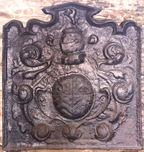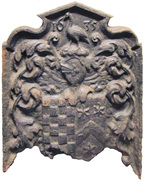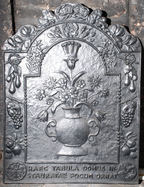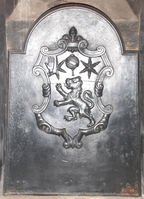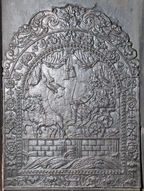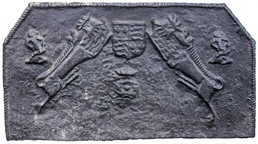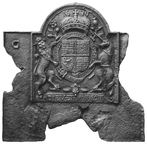-
916
Description: Rectangular, with a detached pediment joined by rebated scrolls; cavetto-moulded edging; circular 'shield' in a cartouche, surmounted by an esquire's helm and lion rampant crest, with mantling behind; initials split by crest; date split in top corners.
Notes: The armorial is of David Prichard (d. 1630) of Llancaiac Fawr Manor; the blazon follows the patriarchal tradition of Welsh heraldry: quarterly, 1st, Sable a lion rampant Argent (for Cydrych ap Gwaithfoed), 2nd, Sable a chevron between three fleurs de lys Argent (for Einion ap Gollwyn), 3rd, Gules three chevrons Argent (for Iestyn ap Gwrgan), and 4th, Sable a chevron between three spear-heads Argent (for Bleddyn ap Maenyrch); the '8' of the date has a flattened top. A copy, from a broken original.
Inscription: D P / 16 28
Arms: Prichard (or ap Richard)
- Decoration tags:
- rectangular with detached pediment (shape)
- cavetto (edging)
- whole carved pattern
- armorial
- text
Manufactured: in 1628 possibly at Dyffryn Furnace in the South Wales area of Wales.
Current location: Llancaiach Fawr Manor, Nelson, Caerphilly, Glamorgan, Wales.
Museum number: GTJ75111 (part of the Caerphilly County Borough Council Museums & Heritage Service museum group)
- Attached to series:
- Personal armorial firebacks
- Welsh armorial firebacks
-
917
Description: Rectangular with detached pediment joined by S-curves; cavetto-moulded edging; shield, helm, bird crest and mantling, with date, 1635, split either side of crest; bottom of casting missing due to corrosion.
Notes: Tentatively identified as the arms of Brooke or Broke of Lapley, Staffordshire (blazon: chequy argent and sable, impaling a chevron between three estoiles); this fireback, or its pattern, have been used as a stamp on another fireback with a later date and initials added separately (see no. 831).
Inscription: 16 35
Arms: poss. Brooke of Staffordshire
- Decoration tags:
- rectangular with detached pediment (shape)
- cavetto (edging)
- whole carved pattern
- armorial
- text
Manufactured: in 1635 in England.
Current location: The Museum of Cambridge, 2/3 Castle Street, Cambridge, Cambridgeshire, England.
(part of the The Museum of Cambridge museum group)
- Attached to series:
- Personal armorial firebacks
-
813
Description: Arched rectangular central panel with bead and fillet edging; two-handled vase with flowers issuing from it, a triple plume of ostrich feathers above, and in the bottom right corner the inscribed inscription, 'CofA' [Charteris of Amisfield]; arched rectangular border with fillet edging; central rose at top of arch with other flowers to each side; successive bunches of pears, grapes and apples descending down each side; inscription (Haec tabula domus instauratae focum ornat) in relief in two rows along the bottom, with circular badges of the National Heritage Memorial Fund to left, and National Trust to right; on top, rope knotted in two loops, each containing half of the date in relief, with descending leaves and flowers on each side.
Notes: This fireback was cast for Martin, Lord Charteris of Amisfield (1913-99), Trustee of the National Heritage Memorial Fund, from a pattern he designed and made, to commemorate the completion of restoration work to Canons Ashby.
Inscription: 1984 / CofA / HAEC TABULA DOMUS IN- / STAURATAE FOCUM ORNAT [this plate adorns the hearth of a restored house]
Manufactured: in 1984 in England.
Current location: Canons Ashby, Canons Ashby, Northamptonshire, England.
Museum number: 494619 (part of the National Trust museum group)
- Attached to series:
- British 'Dutch' style firebacks
- Commemorative firebacks
- Martin Charteris firebacks
-
814
Description: Inclined arched rectangular shape' bevelled fillet edging; cartouche shield of the arms of the baronetcy of Dryden of Canons Ashby.
Arms: Dryden family, probably Sir Henry Edward Leigh Dryden Bt.
- Decoration tags:
- rectangular with round arch (shape)
- bevelled fillet (edging)
- whole carved pattern
- armorial
Manufactured: in the late-19th century in England.
Current location: Canons Ashby, Canons Ashby, Northamptonshire, England.
Museum number: NT/L/CAN/M/78 (part of the National Trust museum group)
- Attached to series:
- Personal armorial firebacks
-
222
Description: Arched rectangular central panel with ‘nutshell’ edging on a broad fillet; crowned figure, holding a sceptre in his right hand, sitting in a chariot drawn to the left by two horses with ostrich feather head-dresses; the whole upon a causeway with pilasters and masonry, and waves beneath; a heron flying to the left; above, swagged drapery with two tassels hanging from the centre; arched rectangular shaped border with fillet edging, symmetrical, flower bunches, descending from a ribbon loop; monogram centre bottom, between plant tendrils; on top, symmetrical scrolled plant tendrils.
Notes: The design is derived from a personification of Europe, one of a set of playing cards entitled 'Jeu de la Géographie', designed by Stefano della Bella (1677); a similarity with Queen Anne may not be coincidental; the flying heron has been copied from a print by Wenceslaus Hollar c.1658.
Copies of this fireback are known.
Inscription: SHR
- Decoration tags:
- 'Dutch' (shape)
- fillet (edging)
- whole carved pattern
- pictorial
- allegorical
- monogram
- text
- animals
- humans
- objects
Manufactured: in the late-17th to early-18th century in England.
Current location: Canons Ashby House, Canons Ashby, Northamptonshire, England.
Museum number: NT/L/CAN/M/79 (part of the National Trust museum group)
- Attached to series:
- SHR series
- British 'Dutch' style firebacks
-
125
Description: Canted rectangle; twisted rope edging (top and sides); top centre, Tudor royal shield between lion passant guardant to right and lion passant guardant sinister to left, both diagonally placed; below, a crowned rose; to left and right, an 'imp' with arms down, facing left.
Notes: One of a large series incorporating royal heraldic stamps. Canterbury Auction Galleries sale, 29 Nov 2017, lot 939 (£300).
Copies of this fireback are known.
Arms: Tudor royal arms of England
- Decoration tags:
- rectangular with canted top corners (shape)
- rope (edging)
- carved stamps
- heraldic
- armorial
- animals
- humans
Manufactured: in the mid-16th century in the Weald area of England.
Current location: not known.
Citation: Lloyd, N., 1925, 'Domestic Ironwork I', Architectural Review, 58, pp. 58-67.
- Attached to series:
- Royal series
-
223
Description: Rectangular; cavetto with double fillet edging; two side panels each separated by twisted rope, and each containing six fleurs de lys arranged vertically; top panel separated by twisted rope, containing inscription; central panel with lion’s head between two fleurs de lys.
Notes: A late example of the use of individual carved stamps; from Heol Ddu Isaf, Bargoed, acquired by the National Museum of Wales in 1922.
Inscription: WLA [triad] 1714 WLA [triad]
- Decoration tags:
- rectangular (shape)
- carved stamps
- individual letters
- individual numbers
- heraldic
- text
Manufactured: in 1714 possibly in the South Wales area of Wales.
Current location: National History Museum, St Fagans, Glamorgan, Wales.
Museum number: 21.31 (part of the Welsh National History Museum museum group)
- Attached to series:
- Miscellaneous stamp firebacks
- Date & initials firebacks
-
224
Description: Composite; Arched rectangular shaped, armorial fireback, cavetto edging, with Stuart Royal arms, garter, supporters, crown and motto, and 1639 date above crown; this overlies a rectangular plate, with rope-effect, fillet edging; a pattern of four rosettes surrounding a fleur-de-lys, its stem terminating in a small buckle, is repeated on each side of the central armorial fireback, with the initials above; each rosette is stamped separately.
Notes: The armorial may originally have been one of the 1619 series. Formerly at Wonastow Court, Momouthshire
Inscription: 1639 / G / HONI SOIT QVI MAL Y PENSE / DIEV ET MO DROIT
Arms: English Stuart royal
- Decoration tags:
- rectangular with round arch (shape)
- fillet (edging)
- whole carved pattern
- composite
- individual letters
- armorial
- text
Manufactured: in 1639 possibly in the Forest of Dean area of England.
Current location: National History Museum, St Fagans, Glamorgan, Wales.
Museum number: 40.428 (part of the Welsh National History Museum museum group)
-
225
Description: Canted rectangle; cavetto moulded edging (top and sides); single horizontal fillet below canted corners and vertical fillet parallel to each side, dividing the fireback into two side panels, two top corner panels, top panel and main central panel; corner panels, ‘daisy’ plant stamp; top panel, date between ‘daisy’ stamps, between initials in triad at each end; side panels, swirling foliage stamp repeated each side above initials, I to left, B to right; centre panel, stamp of ‘Indian’ smoking a pipe at top left, stamp of seated ‘gentleman’ smoking a pipe and holding another, at top right.
Notes: The 'daisy' stamp and the IB initials are identical to those on similar firebacks dated between 1703 and 1721, and probably indicating the same founder. The use of stamps relating to tobacco smoking may suggest an origin near Bristol, the main entry port for the tobacco trade at that time. Formerly at Lilly Hall, Ledbury, Herefordshire.
Inscription: TVI [triad] 1708 TVI [triad] / I B
- Decoration tags:
- rectangular with canted top corners (shape)
- cavetto (edging)
- carved stamps
- individual letters
- individual numbers
- text
- humans
- plants
Manufactured: in 1708 in the Forest of Dean area of England.
Current location: National History Museum, St Fagans, Glamorgan, Wales.
Museum number: 13.90/2 (part of the Welsh National History Museum museum group)
- Attached to series:
- IB series
- Date & initials firebacks
-
226
Description: Arched rectangular shaped central panel with bead-and-pellet edging on a wide fillet; central pedestal with a wyvern fountain ringed with water, and a swan and a duck swimming, plants rising from the waves; above, swags of drapery with two central tassels; arched rectangular shaped border with fillet edging, symmetrical floral fronds descending from a rose, top centre, with a looped 'W' in each shoulder; inscription at base, between date; on top, symmetrical scrolled plant tendrils. A single vertical plankline right of centre.
Notes: One of a group of firebacks all of the same date, some of which have the same Welsh inscription which translates as 'God is our strength'. All incorporate the looped 'W' motif which may be intended to identify the pattern maker. The design is taken from 'Livres de Fontaines' by Daniel Marot (1661-1752) (La Haye & Amsterdam 1701). The swan and the duck swimming may have been copied from etchings or paintings by Francis Barlow (c.1624-1709), whose images of birds have been used incidentally on other firebacks. Formerly at Allt-y-ferin, Nantgaredig, Carmarthenshire.
Copies of this fireback are known.
Inscription: 17 DVW Ydyw Ein Cadernid 24
- Decoration tags:
- 'Dutch' (shape)
- fillet (edging)
- whole carved pattern
- planklines
- pictorial
- architectural
- text
- animals
- plants
- objects
Manufactured: in 1724 in England.
Current location: National History Museum, St Fagans, Glamorgan, Wales.
Museum number: 62.156 (part of the Welsh National History Museum museum group)
- Attached to series:
- 1724 series
- Welsh inscription series
- British 'Dutch' style firebacks
